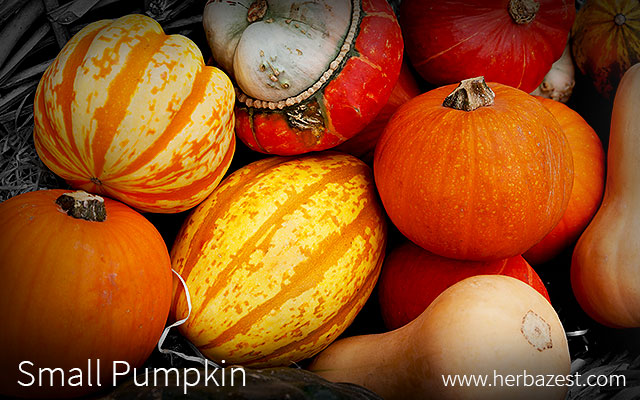Around Halloween time, small pumpkins are sought for kid-friendly craft projects, as well as for a variety of different decorative and culinary purposes.
Pumpkins Come in All Sizes
Small pumpkins and some ornamental gourds are variations of Cucurbita pepo that resulted from a hybridization process started by U.S. farmers in the 1970's in order to produce pumpkins for decorative uses. Today, miniature varieties like the palm-sized 'Jack Be Little' are wildly popular in autumn home décor and small enough to be managed by toddlers. These small pumpkins are valued for their size, shape, longevity, and the thickness of their stem above all else.
Characteristics of Small Pumpkins
A crowded population of pumpkins may produce smaller fruits; however, some cultivars are harvested specifically for their small size. Small pumpkins are under six pounds (3 kg). Some varieties are green and yellow when immature, turning deep orange as the fruit ripens to maturity. They may be smoother, have ridged shapes, and produce significantly less seeds and flesh than their larger counterparts.
Differences between Small Pumpkin Varieties
Though the 'Jack Be Little' miniature is the most common variety of small pumpkin, 'Baby Boos', similar in size and shape, are a white or faint yellow color, with a shorter shelf life. A bit rounder than 'Jack Be Little', 'Wee Be Little' is a tennis ball-sized pumpkin ideal for toddlers, though it may not stand upright on its own due to its spherical shape.
SOME SMALL PUMPKINS ARE EDIBLE. THEIR THICK AND SWEET PULP IS HIGHLY NUTRITIONAL.
Where to Find Small Pumpkins
About 80% of U.S. pumpkins are available throughout the fall. During this time, small pumpkins may be purchased at a number of pumpkin patches, farmers' markets, and supermarkets, and many stores sell them individually for less than one dollar. However, they are significantly harder to obtain outside of peak Halloween season, so canning or freezing your small pumpkins is advisable for long-term storage.
What to Do with Small Pumpkins
Though ornamental pumpkins can be bitter and less enjoyable to the taste in general, some small varieties, like 'Jack Be Little', are popular for both ornamental and culinary use. Small pumpkins can be carved, painted with spooky masks and designs, and also be used to serve party drinks.
Since their flesh is both firm and sweet, small pumpkins are easier to handle for cooking than bulkier varieties. Roasting them in the oven, on the other hand, will be faster, and can make their texture softer for pumpkin pies, breads, and other sweet desserts. A common way to use small pumpkins is to scoop them out and fill them with meat and cooked veggies. They are also less commonly used as feed for livestock.
How to Grow Small Pumpkins in Your Garden
Small pumpkin seeds can be sown in the same way as their larger counterparts and are fairly inexpensive; a 100-gram pack of seeds will cost no more than five dollars in most cases. They can be purchased from local pumpkin patches or in the garden section of major home improvement stores.
ONE SEED CAN PRODUCE EIGHT TO TEN TINY PUMPKINS.
Small pumpkins need plenty of sunshine and will not survive in temperatures below 70F (21C). In colder areas, small pumpkin plants can be started indoors before being transplanted to garden rows about six to eight feet (1.8 - 2.5 m) apart. Dying or browning vines are usually an indication that it is time to harvest your small pumpkins, which by this stage should also have achieved a deep solid color and robust, durable rind. Read a complete guide on how to grow pumpkins.
Small pumpkin varieties are not only prized for their family-friendly use in miniature lantern-making and other Halloween-themed home décor - they are also delicious and nutritious little fruits that offer tons of unique possibilities for cooking and baking.
Sources
- Missouri Botanical Garden, Gardening Help FAQs, Horticulture questions and answers
- Purdue University, Foodlink, Pumpkin
- The Colonial Williamsburg Foundation, Some Pumpkins! Halloween and pumpkins in colonial America
- University of Illinois, Extension Office, Pumpkins and More
- University of South Florida, Center for Instructional Technology, Jack-Be-Little pumpkins
- USDA Nutrient Database




